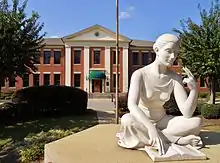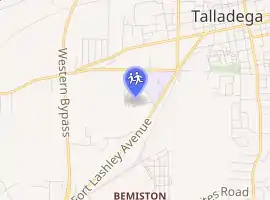Alabama Institute for the Deaf and Blind
The Alabama Institute for Deaf and Blind (AIDB) is a school for people with blindness and/or deafness operated by the U.S. state of Alabama in the city of Talladega. The current institution includes the Alabama School for the Deaf, the Alabama School for the Blind, and the Helen Keller School, named for Alabamian Helen Keller, which serves children who are both deaf and blind. The E. H. Gentry Technical Facility provides vocational training for older students, and the institution offers employment to graduates through its Alabama Industries for the Blind workshops in Talladega and Birmingham. The AIDB has regional centers in Birmingham, Huntsville, Tuscaloosa, Montgomery, Mobile, Dothan, Auburn, and Tuscumbia.[1][2] The AIDB currently serves nearly 24,500 residents from all 67 counties of the state.[3][4]
| Alabama Institute for Deaf and Blind | |
|---|---|
 | |
| Address | |

| |
205 South St E , | |
| Information | |
| Type | Public |
| Established | 1858 |
| President | Dr. John Mascia |
| Grades | Pre-K-12 |
| Color(s) | Red and White |
| Mascot | The School for the Deaf - "Silent Warriors" The School for the Blind - "Redskins" |
| Website | http://aidb.org/home/ |
History
The institution was formed at the suggestion of Joseph Henry Johnson, a former instructor at the Georgia Asylum for the Deaf in Cave Spring.[5] He left that school in 1858 and corresponded with Alabama Governor Andrew B. Moore and State Superintendent of Education William Perry about opening a similar facility in the neighboring state. He purchased property in Talladega and opened the Alabama School for the Deaf on October 4 of that same year. The state purchased the property from him in 1860, but kept him on as president.[1]
In April 1867 Johnson's brother-in-law, Reuben Rogers Asbury, who had suffered an eye injury during the American Civil War, lobbied the state's Reconstruction legislature for funds to add a school for the blind, with himself as teacher. The funding was approved in 1870, and the combined institutions were renamed the Alabama Institute for the Deaf, Dumb and Blind. The school then served about 70 students. As it grew, it was split again into separate schools in 1887. Josiah Graves took over the Alabama Academy for the Blind and Johnson stayed on as head of the School for the Deaf. In 1892, Alabama founded the Alabama School for Negro Deaf-Mutes (later the Alabama School for the Negro Deaf and Blind) nearby, with Graves serving as principal.[1]
The schools taught music, math, religion and home economics as well as vocational programs such as farming and trades. Athletic programs in baseball, basketball and American football were also offered, with the deaf teams going by the name "Silent Warriors". In the late 1870s, a student-run newspaper, The Messenger, published its first edition. The Gospel group, The Blind Boys of Alabama, got their start at the Institute for Negro Blind in 1939.
Johnson's son, Henry Jr., took over at his death. Under his tenure a bakery, model farm and hospital were added, as well as programs for adults with visual impairments. Eugene A. McBride took over as president in 1955 and opened the Helen Keller school (which educated the first deaf and blind student to receive a General Equivalency Diploma). He oversaw the construction of much of the present campus and expanded the institute's outreach to adults, culminating in the vocational center named for his successor, Euel H. Gentry.[1] The Alabama Industries for the Blind has been the sole supplier of neck ties for the United States Armed Forces since the 1960s. In 2006 it also began producing combat helmet covers and ink jet printer cartridges.[6]
The parallel schools were integrated in 1968 following the lawsuit Christine Archie v. AIDB. Under President Jack Hawkins in the 1980s, an AIDB Foundation was created to provide additional financial support for the growing institution. A grant from the W. K. Kellogg Foundation helped underwrite the creation of regional centers around the state. The current president is Dr. John Mascia.[1]
References
Notes
- "Alabama Institute for Deaf and Blind (AIDB)". Encyclopedia of Alabama. Retrieved March 19, 2011.
- Couch, Robert Hill (1983). Out of Silence and Darkness: The History of the Alabama Institute for Deaf and Blind, 1858-1983. Troy, Alabama: Troy State University Press.
- "Fact Sheet". Alabama Institute for Deaf and Blind. Archived from the original on March 12, 2011. Retrieved March 19, 2011.
- "The AIDB Story". Alabama Institute for Deaf and Blind. Archived from the original on March 12, 2011. Retrieved March 19, 2011.
- Gannon, Jack. 1981. Deaf Heritage–A Narrative History of Deaf America, Silver Spring, MD: National Association of the Deaf, pp. 33-34 (PDF Archived 2012-03-28 at the Wayback Machine)(PDF Archived 2012-03-28 at the Wayback Machine)
- Myers, Rose (Summer 2006). "Fighting the War at Home" (PDF). Sights and Sounds. Alabama Institute for the Deaf and Blind. Archived from the original (PDF) on January 29, 2012. Retrieved March 19, 2011.
Further viewing
- Wiseman, Frederick (Director) (1986). Adjustment & Work (motion picture). Zipporah Films.
- Wiseman, Frederick (Director) (1987). Blind (motion picture). Zipporah Films.
- Wiseman, Frederick (Director) (1986). Blind (motion picture). Zipporah Films.
External links
- Alabama Institute for the Deaf and Blind official website